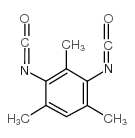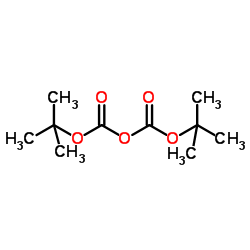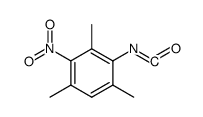16959-10-7
| 中文名 | 2,4,6-三甲基-1,3-次苯基二异氰酸盐 |
|---|---|
| 英文名 | 2,4-diisocyanato-1,3,5-trimethylbenzene |
| 中文别名 |
三甲基-1,3-次苯基二异氰酸盐
2,3-二甲氧基-5-磺酰胺基苯甲酸 2,4,6-三甲基-1,3-亚苯基二异氰酸盐 |
| 英文别名 |
2,4,6-trimethylphenyl 1,3-diisocyanate
2,4,6-Trimethyl-1,3-phenylene diisocyanate 2,4,6-Trimethylbenzol-1,3-diyldiisocyanat 2,4,6-trimethylbenzene-1,3-diisocyanate Mesitylendiisocyanat MFCD00673067 1.3.5-Trimethylbenzen-2.4-diisocyanat |
| 密度 | 1.2107 (rough estimate) |
|---|---|
| 沸点 | 102ºC0.4 mm Hg(lit.) |
| 熔点 | 57-60ºC(lit.) |
| 分子式 | C11H10N2O2 |
| 分子量 | 202.20900 |
| 闪点 | >230 °F |
| 精确质量 | 202.07400 |
| PSA | 58.86000 |
| LogP | 2.54640 |
| 折射率 | 1.5300 (estimate) |
| 储存条件 | 保持贮藏器密封 放入紧密的贮藏器内,储存在阴凉,干燥的地方 |
| 稳定性 | 遵照规定使用和储存则不会分解。 |
| 分子结构 | 1、 摩尔折射率:57.94 2、 摩尔体积(m3/mol):182.5 3、 等张比容(90.2K):452.5 4、 表面张力(3.0 dyne/cm):37.7 5、 极化率(0.5 10 -24cm 3):22.97 |
| 计算化学 | 1.疏水参数计算参考值(XlogP):4.6 2.氢键供体数量:0 3.氢键受体数量:4 4.可旋转化学键数量:2 5.互变异构体数量:无 6.拓扑分子极性表面积58.9 7.重原子数量:15 8.表面电荷:0 9.复杂度:287 10.同位素原子数量:0 11.确定原子立构中心数量:0 12.不确定原子立构中心数量:0 13.确定化学键立构中心数量:0 14.不确定化学键立构中心数量:0 15.共价键单元数量:1 |
| 更多 | 1. 性状:无可用 2. 密度(g/mL,25/4℃):无可用 3. 相对蒸汽密度(g/mL,空气=1):无可用 4. 熔点(ºC):57-60 5. 沸点(ºC,常压):102/0.4mmHg 6. 沸点(ºC,5.2kPa):无可用 7. 折射率:无可用 8. 闪点(ºC):无可用 9. 比旋光度(º):无可用 10. 自燃点或引燃温度(ºC):无可用 11. 蒸气压(kPa,25ºC):无可用 12. 饱和蒸气压(kPa,60ºC):无可用 13. 燃烧热(KJ/mol):无可用 14. 临界温度(ºC):无可用 15. 临界压力(KPa):无可用 16. 油水(辛醇/水)分配系数的对数值:无可用 17. 爆炸上限(%,V/V):无可用 18. 爆炸下限(%,V/V):无可用 19. 溶解性:无可用 |
Synonym:None Section 2 - COMPOSITION, INFORMATION ON INGREDIENTS
Risk Phrases: 20/21/22 36/37/38 Section 3 - HAZARDS IDENTIFICATION EMERGENCY OVERVIEW
Harmful by inhalation, in contact with skin and if swallowed. Irritating to eyes, respiratory system and skin.Moisture sensitive. Potential Health Effects Eye: Causes eye irritation. Lachrymator (substance which increases the flow of tears). Skin: Causes skin irritation. Harmful if absorbed through the skin. Organic isocyanates can cause local irritation and allergic reactions. Ingestion: Harmful if swallowed. Inhalation: Causes respiratory tract irritation. The toxicological properties of this substance have not been fully investigated. At high concentrations, isocyanates affect mucous membranes of the respiratory tract and may lead to fatal pulmonary edema. Exposure to low and often even unmeasurable isocyanate concentration results in sensitization. Chronic: Repeated or prolonged exposure may cause allergic reactions in sensitive individuals. Chronic overexposure to isocyanates has been reported to cause lung damage, including decreased lung fuction, which may be permanent. Section 4 - FIRST AID MEASURES Eyes: Immediately flush eyes with plenty of water for at least 15 minutes, occasionally lifting the upper and lower eyelids. Get medical aid. Do NOT allow victim to rub eyes or keep eyes closed. Skin: Get medical aid. Flush skin with plenty of water for at least 15 minutes while removing contaminated clothing and shoes. Wash clothing before reuse. Ingestion: Get medical aid. Do NOT induce vomiting. If conscious and alert, rinse mouth and drink 2-4 cupfuls of milk or water. Inhalation: Remove from exposure and move to fresh air immediately. If not breathing, give artificial respiration. If breathing is difficult, give oxygen. Get medical aid. Do NOT use mouth-to-mouth resuscitation. If breathing has ceased apply artificial respiration using oxygen and a suitable mechanical device such as a bag and a mask. Notes to Physician: Treat symptomatically and supportively. Section 5 - FIRE FIGHTING MEASURES General Information: As in any fire, wear a self-contained breathing apparatus in pressure-demand, MSHA/NIOSH (approved or equivalent), and full protective gear. During a fire, irritating and highly toxic gases may be generated by thermal decomposition or combustion. Extinguishing Media: Use agent most appropriate to extinguish fire. Section 6 - ACCIDENTAL RELEASE MEASURES General Information: Use proper personal protective equipment as indicated in Section 8. Spills/Leaks: Vacuum or sweep up material and place into a suitable disposal container. Clean up spills immediately, observing precautions in the Protective Equipment section. Avoid generating dusty conditions. Provide ventilation. Section 7 - HANDLING and STORAGE Handling: Wash thoroughly after handling. Use with adequate ventilation. Minimize dust generation and accumulation. Avoid contact with eyes, skin, and clothing. Keep container tightly closed. Avoid ingestion and inhalation. Do not allow contact with water. Wash clothing before reuse. Keep from contact with moist air and steam. Isocyanates react with water to form CO2 gas. This gas can cause sealed containers to expand and possibly rupture. Storage: Store in a tightly closed container. Store in a cool, dry, well-ventilated area away from incompatible substances. Store protected from moisture. Section 8 - EXPOSURE CONTROLS, PERSONAL PROTECTION Engineering Controls: Facilities storing or utilizing this material should be equipped with an eyewash facility and a safety shower. Use adequate ventilation to keep airborne concentrations low. Exposure Limits CAS# 16959-10-7: Personal Protective Equipment Eyes: Wear appropriate protective eyeglasses or chemical safety goggles as described by OSHA's eye and face protection regulations in 29 CFR 1910.133 or European Standard EN166. Skin: Wear appropriate protective gloves to prevent skin exposure. Clothing: Wear appropriate protective clothing to prevent skin exposure. Respirators: A respiratory protection program that meets OSHA's 29 CFR 1910.134 and ANSI Z88.2 requirements or European Standard EN 149 must be followed whenever workplace conditions warrant respirator use. Section 9 - PHYSICAL AND CHEMICAL PROPERTIES Physical State: Solid Color: white to off-white Odor: Not available. pH: Not available. Vapor Pressure: Not available. Viscosity: Not available. Boiling Point: 102 deg C @ .40 mm Hg Freezing/Melting Point: 57-60C Autoignition Temperature: Not applicable. Flash Point: > 109 deg C (> 228.20 deg F) Explosion Limits, lower: Not available. Explosion Limits, upper: Not available. Decomposition Temperature: Solubility in water: Specific Gravity/Density: Molecular Formula: C11H10N2O2 Molecular Weight: 202.08 Section 10 - STABILITY AND REACTIVITY Chemical Stability: Stable at room temperature in closed containers under normal storage and handling conditions. Conditions to Avoid: Moisture, excess heat. Incompatibilities with Other Materials: Strong oxidizing agents. Hazardous Decomposition Products: Hydrogen cyanide, nitrogen oxides, carbon monoxide, irritating and toxic fumes and gases, carbon dioxide. Hazardous Polymerization: Will not occur. Section 11 - TOXICOLOGICAL INFORMATION RTECS#: CAS# 16959-10-7 unlisted. LD50/LC50: Not available. Carcinogenicity: 2,4,6-Trimethyl-1,3-phenylene diisocyanate - Not listed by ACGIH, IARC, or NTP. Section 12 - ECOLOGICAL INFORMATION Section 13 - DISPOSAL CONSIDERATIONS Dispose of in a manner consistent with federal, state, and local regulations. Section 14 - TRANSPORT INFORMATION IATA Shipping Name: ISOCYANATES, TOXIC, N.O.S.* Hazard Class: 6.1 UN Number: 2206 Packing Group: III IMO Shipping Name: ISOCYANATES, TOXIC, N.O.S. Hazard Class: 6.1 UN Number: 2206 Packing Group: III RID/ADR Shipping Name: ISOCYANATES, TOXIC, N.O.S. Hazard Class: 6.1 UN Number: 2206 Packing group: III Section 15 - REGULATORY INFORMATION European/International Regulations European Labeling in Accordance with EC Directives Hazard Symbols: XN Risk Phrases: R 20/21/22 Harmful by inhalation, in contact with skin and if swallowed. R 36/37/38 Irritating to eyes, respiratory system and skin. Safety Phrases: S 26 In case of contact with eyes, rinse immediately with plenty of water and seek medical advice. S 36/37/39 Wear suitable protective clothing, gloves and eye/face protection. WGK (Water Danger/Protection) CAS# 16959-10-7: No information available. Canada None of the chemicals in this product are listed on the DSL/NDSL list. CAS# 16959-10-7 is not listed on Canada's Ingredient Disclosure List. US FEDERAL TSCA CAS# 16959-10-7 is not listed on the TSCA inventory. It is for research and development use only. SECTION 16 - ADDITIONAL INFORMATION N/A |
|
生态学数据: 该物质对环境可能有危害,对水体应给予特别注意。
|
| 危害码 (欧洲) | Xn: Harmful; |
|---|---|
| 风险声明 (欧洲) | R20/21/22 |
| 安全声明 (欧洲) | S23 |
| WGK德国 | 3 |
| 海关编码 | 2929109000 |
|
~65% 
16959-10-7 |
| 文献:Saylik, Dilek; Horvath, Michael J.; Elmes, Patricia S.; Jackson, W. Roy; Lovel, Craig G.; Moody, Keith Journal of Organic Chemistry, 1999 , vol. 64, # 11 p. 3940 - 3946 |
|
~83% 
16959-10-7 |
| 文献:Knoelker, Hans-Joachim; Braxmeier, Tobias; Schlechtingen, Georg Angewandte Chemie, 1995 , vol. 107, # 22 p. 2746 - 2749 |
|
~63% 
16959-10-7 |
| 文献:Bulletin of the Academy of Sciences of the USSR, Division of Chemical Science (English Translation), , vol. 29, # 1 p. 117 - 120 Izvestiya Akademii Nauk SSSR, Seriya Khimicheskaya, , # 1 p. 133 - 136 |
| 上游产品 5 | |
|---|---|
| 下游产品 0 | |
| 海关编码 | 2929109000 |
|---|---|
| 中文概述 | 2929109000. 其他异氰酸酯. 增值税率:17.0%. 退税率:13.0%. 监管条件:无. 最惠国关税:6.5%. 普通关税:30.0% |
| 申报要素 | 品名, 成分含量, 用途 |
| Summary | 2929109000. other isocyanates. VAT:17.0%. Tax rebate rate:13.0%. . MFN tariff:6.5%. General tariff:30.0% |






